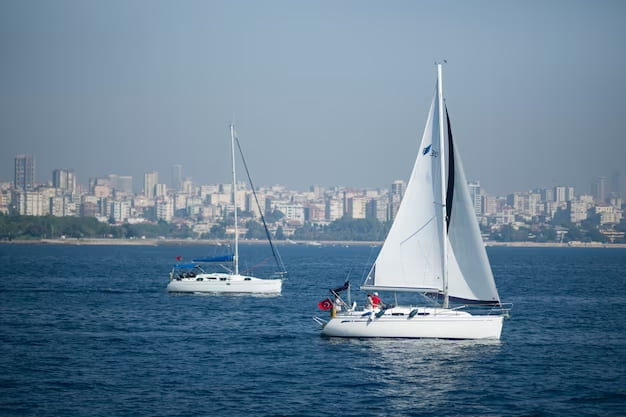Understanding the Jib Sail: Essential Component of Sailing
The jib sail, a key element of a sailboat, is a triangular sail positioned ahead of the mast. Its versatility in size and shape makes it suitable for various sailing conditions, playing a crucial role in the vessel’s performance.
The Significance of a Jib Sail in Sailing
This triangular sail significantly enhances a sailboat’s navigation capabilities. Positioned at the forefront, it’s pivotal in capturing wind power and assisting in maneuvering and speed control. Unlike the mainsail, the jib relies less on direct force, adapting swiftly to changing winds for optimal sailing.
Navigating with a Jib: Tips and Techniques
Efficient use of the jib sail necessitates an understanding of wind conditions and sail adjustments. While some sailors prefer sailing with the jib alone, it’s essential to balance this preference with knowledge of sail dynamics.
The Anatomy of a Jib Sail
Understanding a jib sail’s parts, such as the luff, leech, foot, tack, head, and clew, is crucial for effective sailing. Each component plays a specific role in the sail’s performance.
Adjusting and Maintaining Your Jib
Maintaining and adjusting a jib sail is vital for optimal sailing performance. Regularly inspecting the sail for wear and tear, particularly along seams and attachment points, ensures longevity. When adjusting the jib, focus on the halyard tension to maintain the sail’s shape. The clew and yard position is crucial for effective wind capture. In varying wind conditions, adapt the Cunningham and outhaul settings.
The right balance in the jib’s trim is essential: an overly tight jib can hinder maneuverability, while a too-loose jib fails to harness wind efficiently. Regular cleaning, safe storage, and professional repairs when needed are key maintenance practices. By understanding and applying these practices, sailors can ensure their jib sail remains a reliable and effective component of their vessel.
The Variety of Jib Sails and Their Uses :
The variety in jib sails caters to diverse sailing conditions and styles. Standard jibs are all-rounders, suitable for various wind conditions and sailing purposes. Genoas, larger, excel in upwind performance, providing more power by capturing additional wind. They are ideal for racers and cruisers needing extra thrust. Storm jibs, smaller and sturdier, are designed for heavy weather sailing, offering stability and safety during high winds. Racing jibs are tailored for competitive sailing, emphasizing lightweight materials for speed and quick response. Selecting the appropriate jib sail depends on factors like the size of the boat, prevailing wind conditions, and the sailor’s experience. Understanding each type’s unique features and optimal conditions can significantly enhance a sailor’s adaptability and success on the water.
Jib Sail Materials: Making the Right Choice
The material of a jib sail plays a crucial role in its performance and durability. Polyester, particularly laminated Dacron, is a popular choice for its balance between durability and performance, suitable for cruisers who prioritize longevity. For racers, materials like Kevlar offer lightweight advantages and minimal stretch, crucial for maintaining sail shape and maximizing speed.
However, Kevlar’s susceptibility to UV damage and higher cost makes it less ideal for cruising. Advanced materials like carbon fiber and laminates combine light weight with high strength, but their cost and maintenance requirements may not suit all sailors. Sailors should consider factors like sailing style, frequency, budget, and expected conditions when selecting jib sail materials. The right material choice can greatly affect the sail’s efficiency, ease of handling, and overall sailing experience.
Key Points: The Role of a Jib Sail
- Enhanced Maneuverability: The jib sail’s position and shape provide better control and agility for the sailboat;
- Wind Adaptation: Its ability to adjust to varying wind conditions optimizes sailing performance;
- Variability in Size: Jibs can be customized in size to suit different sailing needs and conditions;
- Essential for Navigational Precision: Critical for fine-tuning the boat’s direction and speed.
Comparative Table: Types of Jib Sails
| Jib Type | Usage | Characteristics |
|---|---|---|
| Standard Jib | General Sailing | Balanced size, versatile for various conditions |
| Genoa | Upwind Performance | Larger, extends beyond the mast for more power |
| Storm Jib | Harsh Weather | Smaller, robust design for high wind stability |
| Racing Jib | Competitive Sailing | Lightweight, designed for speed and agility |
Conclusion
In summary, the jib sail is an indispensable component of a sailboat, offering both functional and aesthetic value. Understanding its role, types, and maintenance can significantly enhance sailing efficiency and enjoyment.

Leave a Reply